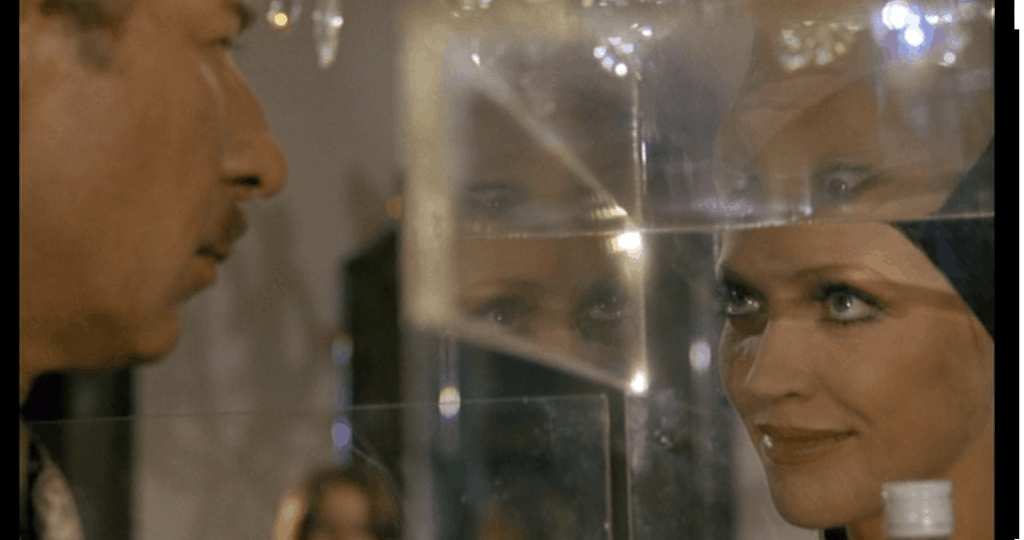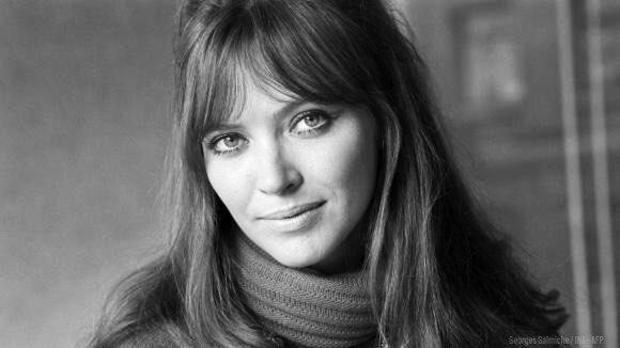In Chris Petit’s third film, Flight to Berlin (1984), Eddie Constantine plays “Eddie“. At one point in the film, a character (falsely) introduces herself as Marianne. Eddie answers, “I once knew a woman called Marianne, or was it Natacha?” In a film littered with cinematic references, this is an obvious nod to Alphaville (Alphaville, Une étrange aventure de Lemmy Caution 1965), where Constantine appeared opposite Anna Karina’s Natacha von Braun. That was one of the two films Karina made with Jean-Luc Godard in 1965. The other was Pierrot le fou, where she played a character called Marianne.
Born Hanne Karin Bayer in Solbjerg, Denmark, in 1940, Karina moved to France at the age of 17. After a while, she started modelling. A Palmolive ad caught Godard’s eye, and he offered her a role in A bout de souffle (1960). Since the minor part contained nudity, Karina refused. Instead, her first film with Godard would be Le Petit soldat. It was shot the same year, but since it dealt with the Algerian war and featured torture scenes, the film was banned until 1963. Thus, the first film with Karina being shown publicly was Michel Deville’s delightful Ce soir ou jamais (1961).
Living her life with Godard
Karina and Godard married in 1961. She would appear in seven of his films. The musical comedy Une femme est une femme (1961) brought her the Silver Bear for best actress at Berlinale. Vivre sa vie – Film en douze tableaux (1962) is very different. It’s in black and white and is the closest Godard ever came to a love portrait of his wife.
The film begins with a long sequence with Karina (playing Nana) being shown from the sides and en face, respectively. The sequence ends with a quote from Montaigne “Il faut se prêter aux autres et se donner a soi-mème.” (Lend yourself to others, but give yourself to yourself.) As she later becomes a prostitute, she doesn’t really adhere to that statement. Late in the film, when a young man reads The Oval Portrait by Edgar Allan Poe to Nana, it’s actually Godard who does the actual reading.
Pierrot le fou (1965) is much more colourful. Made the same year as Alphaville, after the couple’s divorce. Jean-Paul Belmondo stars as Ferdinand (constantly being called Pierrot by Marianne), and a substantial part of the film is about the couple’s inability to communicate. In a scene that is largely improvised, that fact is summed up in Marianne’s phrase: “Parce que tu me parles avec des mots, que moi je te regarde avec des sentiments.”( Because you talk to me with words, and I look at you with feelings.) This is one of the few scenes that was actually improvised. At this stage of their collaboration, Karina had learned to pretend that she was improvising.
Godard and Karina were to make one more film together, Made in U.S.A. (1966) and also one segment of the anthology film, Le plus vieux métier du monde (1967). Even if Karina is mostly remembered for the Godard films, she was quite prolific and acted with several influential directors in numerous films. The first was La Religieuse (1966) by Jacques Rivette, where she played the leading role of Suzanne in one of the director’s more academic efforts. It became infamous since it was banned by the state at the time. Godard wrote an open letter about the affair to the “Minister of Kultur” André Malraux. The film had many strong performances, and Karina’s was certainly one of them.
Collaborations with other directors
Karina would go on to work with directors such as Volker Schlöndorff, André Delvaux, Marta Mészárós, Rainer Werner Fassbinder and Raoul Ruiz. With Delvaux, she actually worked twice, and it’s worth taking a closer look at their first collaboration, Rendez-Vous à Bray (1971). The story is set during the First World War. A young pianist (Delvaux regular, Matthieu Carrière) is supposed to meet a friend in his country house.
Once he arrives, the friend is absent, and the only person present is a mysterious woman played by Karina. The latter doesn’t have many lines ( I haven’t performed the Anna Paquin test), but she has a strong presence, which is often linked to how she connects with various objects, notably, but not exclusively, a candelabra. The film is rather closer to Le Nouveau Roman (The new novel) than The New Wave and was, in a way, an artistic leap for Karina, which she handled with aplomb. She was, of course, aided by a master filmmaker whose films are always worth checking out.
Fassbinder’s Chinesisches Roulette (1976) was a French co-production and featured Macha Méril (who played the lead in Godard’s Une femme mariée) as well as Anna Karina. The latter plays Angela, who is the French mistress of the father in a family where both parties have a lover. Obviously, the interpreters don’t play the first fiddle in this play of framing and reframing by Fassbinder and Michael Ballhaus, but she still makes quite an impression.
Anna Karina as a Director
Anna Karina would also move on to directing. In 1973, she wrote, produced, directed and starred in Vivre Ensemble. A film in the New Wave vein that, in some ways, could be seen as a companion piece to Vivre sa vie. Like that one, Vivre ensemble is also divided into tableaux, but instead of 12, she opted for 7. (6 numerated and an epilogue of sorts called Le dernier tableau). The story revolves around a professor (Michel Lancelot) who falls in love with hippie-dippie outsider Julie (Karina). In the process, he abandons his former life without considering the consequences.

The storyline is set in Paris before a sudden trip to New York. The freewheeling style is typical of a film of the late sixties/early seventies. It features a song that is repeated numerous times in slightly different versions, although nowhere near as skillfully as the theme in The Long Goodbye, made the same year. The film was digitally restored and released on Blu-ray in 2017. There were also screenings in Paris, in the director’s presence in 2018. Karina would also direct a second film in 2008 called Victoria, which I haven’t seen.
Even if I’m not as averse to the term muse as others seem to be, it’s clear that there was more to Anna Karina than simply being Godard’s muse.




Pingback: The Creatures of Agnès Varda's vision - The Disapproving Swede